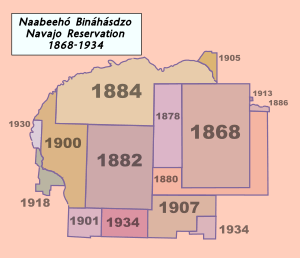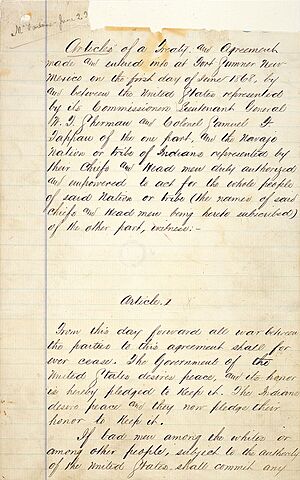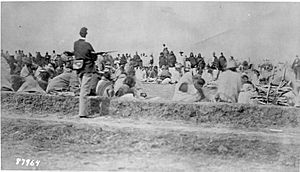Treaty of Bosque Redondo facts for kids
The Treaty of Bosque Redondo was an important agreement between the Navajo and the U.S. Government. It was signed on June 1, 1868. This treaty is also known by its Navajo names, Naal Tsoos Sani or Naaltsoos Sání.
The treaty officially ended the Navajo Wars. It allowed the Navajo people to return home after being held in camps at Fort Sumner. They had been forced to march there during the Long Walk in 1864. This agreement also made the Navajo a sovereign nation. This means they could govern themselves and make their own rules.
Contents
Why the Treaty Was Needed
Before the treaty, there were many conflicts between the Navajo and U.S. forces. A U.S. military leader named Kit Carson used "scorched earth" tactics. This meant burning Navajo crops and killing their animals.
In 1862, General James Henry Carleton ordered all Navajo people to move. They had to go to the Bosque Redondo Reservation near Fort Sumner. The Navajo called this place Hwéeldi, which means "the land of suffering." If they refused to go, they would face military action.
This order led to the Long Walk of 1864. About 8,000 to 10,000 Navajo and Apache people were forced to march. This group included women and children. They walked over 350 miles from their homeland near the Four Corners area.
General Carleton wanted the Navajo to become farmers at Bosque Redondo. He hoped they would live in villages and learn American ways. However, the reservation was a very difficult place. The soil was poor, and there was not enough water for farming. The Pecos River also caused floods. Many crops were destroyed by worms and floods. Many Navajo people died from sickness and hunger.
The Bosque Redondo camp was also very expensive for the government. By 1865, feeding and guarding the Navajo cost about $1,250,000. General William Tecumseh Sherman thought this was too much money. He said the government could not keep paying for this "extravagant system."
Because of the bad conditions and high costs, the U.S. Congress debated the issue. A group called the Doolittle Committee was formed to investigate. They looked into the terrible conditions at the camp. In 1867, General Carleton was removed from his command.
A new group, the Indian Peace Commission, was created. They suggested making a treaty with the Navajo. This treaty would allow them to move to a new area where they could support themselves.
After making another treaty with the Sioux people, General William Tecumseh Sherman and Samuel F. Tappan went to meet the Navajo. They wanted to end the difficult situation at Bosque Redondo. They met with Barboncito, a Navajo leader, and 10 other important Navajo men.
Negotiating the Agreement
Sherman and Tappan arrived at Fort Sumner on May 28, 1868. They had full power from Congress to create a treaty. The conditions at the reservation shocked them. Tappan compared the Navajo's suffering to that of Civil War prisoners. Sherman said the Navajo were in "absolute poverty and despair."
At first, Sherman suggested moving the Navajo to the Indian Territory (which is now Oklahoma). He offered to send a group to explore the area. But Barboncito refused. The Navajo leaders were firm: they would not plant crops at Bosque Redondo again.
Barboncito spoke about the many problems. He talked about his people and their animals dying. He spoke of their hard work being for nothing. He mentioned the bad land and the shame of having to get food from the government. He also spoke of the long walks to find wood for fires.
The U.S. agent for the Navajo told the commissioners that the Navajo were determined to leave Bosque Redondo. He warned that if they were not allowed to return home, they would leave anyway. Sherman then sent a message to Congress. He said the Navajo would not agree to move to Texas or any place further east. He warned that only a huge military force could make them stay at Bosque Redondo.
Tappan had wanted the Navajo to return home from the start. Sherman finally agreed. He realized the land at Bosque Redondo was not good for anyone. The next step was to decide the exact area where the Navajo would return. The talks were difficult because they needed to translate from English to Spanish, then from Spanish to Navajo.
Sherman agreed that the Navajo could hunt and trade outside their reservation. But they had to live and farm within its borders.
Signing the Treaty
No matter what was written in the "white man's document," the Navajo people only wanted to go home. On June 1, 1868, 29 Navajo leaders made their mark on the treaty. This officially signed the agreement. The U.S. Senate approved it on June 24, 1868. President Andrew Johnson signed it into law on August 12.
What the Treaty Said
The treaty had 13 sections, called articles. Many parts were similar to the Treaty of Fort Laramie made with the Sioux earlier that year. Like many treaties of that time, it included rules to encourage the Navajo to become farmers.
Here are some of the main things the treaty said:
- The Navajo would stop all raids. They would stay on the new reservation in Arizona and New Mexico. They would give up claims to land outside this reservation. The new reservation was about 3,500,000 square miles. But it did not include some of the best land for farming and grazing.
- The U.S. government would give the Navajo farming tools and seeds. Each family would get 160 acres of land. The government also agreed to provide 15,000 sheep and goats, and 500 cattle.
- The government would pay $10 each year for 10 years to families who farmed or worked with tools. This money was for buying things they needed. Those who did not farm would get $5 payments.
- For ten years, the government would provide supplies for the reservation. These supplies would be worth $100 for the first year, and $25 for the next two years.
- The Navajo agreed to send their children, aged six to 13, to school for ten years. The government agreed to provide one teacher for every 30 students.
- If someone from the tribe committed a crime, they would be judged by U.S. federal law, not tribal law.
- The Navajo agreed not to bother railroad construction. They also promised not to harm any wagon trains or cattle.
What Happened Next

By signing the treaty, the U.S. government recognized the Navajo Nation as a sovereign nation. This meant they had their own government, even though they still depended on the U.S. government.
However, some historians say the treaty also meant the Navajo lost some of their freedom. They came under American rule. Navajo leaders signed the treaty because they had no other choice. They did what was needed so their people could have a future.
The Navajo's "Long Walk Home" was special. They are one of the few Native American groups in U.S. history to successfully return to their homeland after being forced to leave. Even though the Bosque Redondo experiment failed, the treaty did end the Navajo wars. It also made the Navajo dependent on the U.S. government.
On June 18, 1868, about 8,000 Navajo people began their journey home. They brought about 2,000 sheep and 1,000 horses. They traveled about 12 miles each day. They arrived too late in the year to plant crops. So, they had to rely on government food and wild plants. They also got help from Navajo people who had avoided being captured. The Navajo people struggled with poverty for several years.
The new Navajo reservation was much smaller than their original lands. It was only about 10% to 25% of their old territory. It also did not include much of the best grazing land. White settlers had taken over much of this land while the Navajo were at Bosque Redondo.
The exact borders of the reservation were not always clear. By 1869, about half of the Navajo lived outside the official reservation. This was helpful for both sides. The Navajo had more freedom to move around. And the government could claim the Navajo did not follow the agreement. This saved the government a lot of money in promised aid.
In the end, many of the benefits the government promised to the Navajo never fully happened.
Remembering the Treaty
June 1, 1868, is known as Treaty Day among the Navajo. They have celebrated it many times. For example, on June 1, 1999, thousands gathered at Northern Arizona University for a ceremony.
In May 2018, one of the two remaining original copies of the treaty was moved. It went to the Navajo Nation Museum. It was displayed there to mark the 150th anniversary of the signing. Other ceremonies were held at the Bosque Redondo Memorial. This memorial was built in 2005 and has a museum where the second original copy of the treaty was shown.
Images for kids






